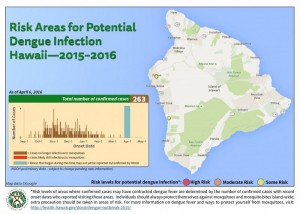DOH Map on Dengue Lists Kalaoa, Hookena Areas at ‘Some Risk’

The Hawai’i Department of Health updated its map of potential areas of dengue fever infection, based on confirmed case information as of Wednesday, April 13. DOH image.
Wednesday marks three weeks since the last confirmed dengue fever case was reported by the Hawai’i Department of Health.
Since the onset of the Big Island’s dengue outbreak in September, 263 cases have been confirmed, including 237 residents and 26 visitors.
No cases have been infectious to mosquitoes since March 25, according to DOH.
Seven potential cases were excluded from the overall count between Tuesday and Wednesday, making the number a total of 1,608 potential cases excluded since September.
Potential dengue fever cases excluded were either deemed negative following laboratory testing or lacked case criteria.
In the DOH’s updated Risk Area for Potential Dengue Infection map released Wednesday afternoon, just two locations remained: Kalaoa and the Hookena area. Both locations were reduced last week to “some risk” areas. The locations remain at the same level this week.
Symptoms of dengue fever include fever, joint or muscle pain, headache or pain behind the eyes, and rash.
Those interested in obtaining general information about the current Big Island dengue fever investigation should call 2-1-1 and talk with Aloha United Way.
Anyone who thinks they may have contracted dengue fever on the Big Island should call 933-0912 if they are located in East Hawai‘i or 322-4877 in West Hawai‘i. If an individual is currently ill and concerned that they may have contracted dengue fever, they should contact their primary care physician.
Civil Defense suggests the following to aid in reducing potential mosquito breeding areas around homes and businesses:
Remove or eliminate standing water that provides sources for mosquito breeding such as buckets or puddles.
- Fix leaky faucets and outdoor hoses that are dripping water.
- Treat bromeliads and other plants that hold water with a larvacide or chlorine bleach solution.
- Clean gutters to allow water to drain freely.
- Repair screens and windows to help keep mosquitoes out.
- Dispose of old tires at no charge at county transfer stations islandwide.
Mosquito concerns should be reported to 974-6010 in East Hawai‘i or 322-1513 in West Hawai’i.













